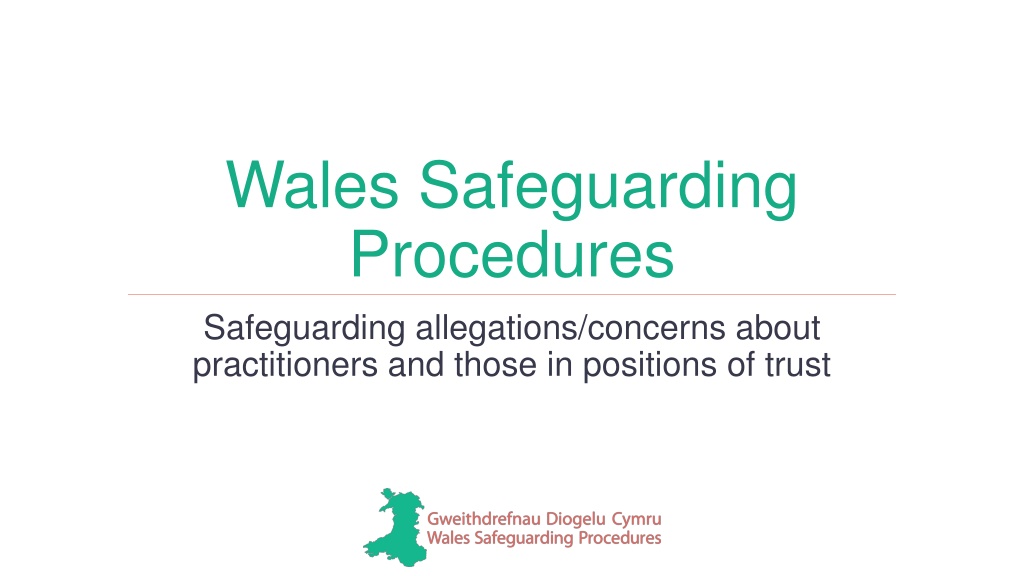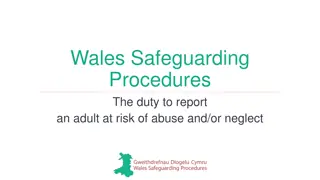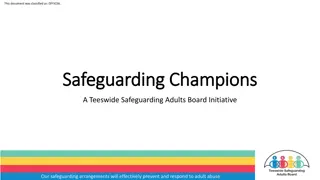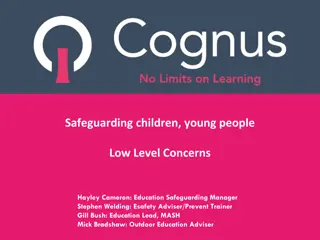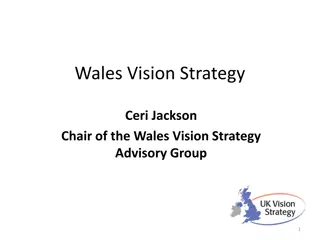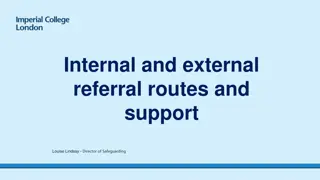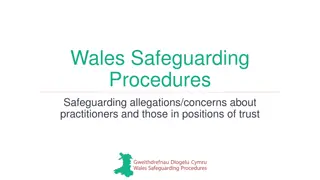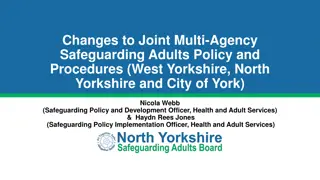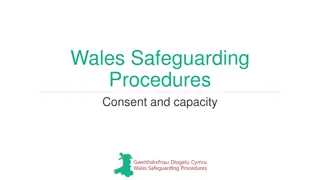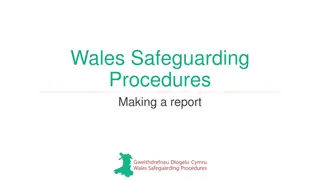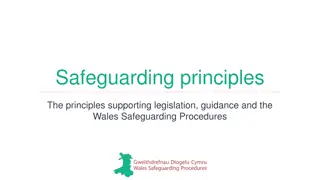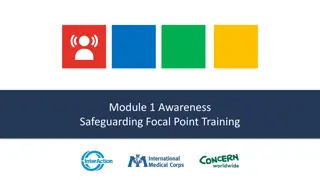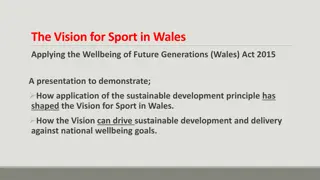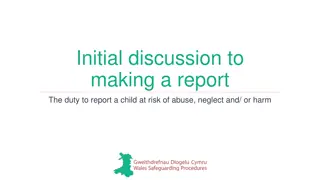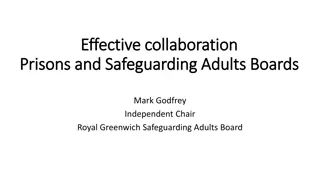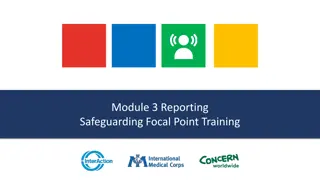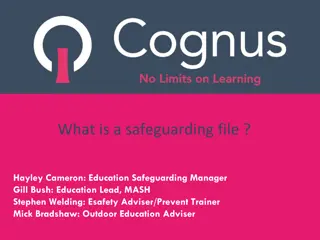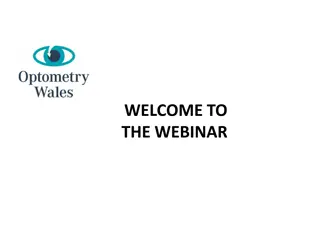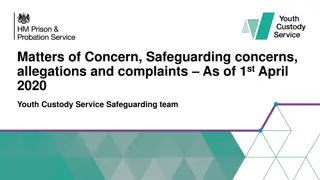Safeguarding Procedures in Wales for Reporting Concerns
Safeguarding procedures in Wales outline how to respond to concerns about individuals in positions of trust with children or adults at risk. Everyone has a responsibility to report safeguarding concerns, including concerns about practitioners, regardless of their status or authority. These procedures aim to protect vulnerable individuals and ensure fair and timely handling of allegations. The process involves reporting concerns to social services or the police to prevent potential risks.
Download Presentation

Please find below an Image/Link to download the presentation.
The content on the website is provided AS IS for your information and personal use only. It may not be sold, licensed, or shared on other websites without obtaining consent from the author. Download presentation by click this link. If you encounter any issues during the download, it is possible that the publisher has removed the file from their server.
E N D
Presentation Transcript
Wales Safeguarding Procedures Safeguarding allegations/concerns about practitioners and those in positions of trust
You should also apply the following legislation and guidance: Social Services and Well-being (Wales) Act 2014 Working Together to Safeguard People: Volume 5 Handling Individual Cases to Protect Children at Risk Working Together to Safeguard People: Volume 6 Handling Individual Cases to Protect Adults at risk Safeguarding children in education: handling allegations of abuse against teachers and other staff, Welsh Government 2014
Wales Safeguarding Procedures App
What are these procedures about? How to respond appropriatelyto safeguarding concerns about peoplewhose paid or voluntary work brings them into contact with children or adults at risk This also includes individuals who have caring responsibilities for children or adults in need of care and support, and their employment or voluntary work brings them into contact with children or adults at risk
Who has responsibility to report? We all have a responsibility to report safeguarding concerns, regardless of a person s status, profession or authority You must report concerns about the conduct or behaviour of a practitioner/person in a position of trust to social services or the police This includes your private life you must report concerning behaviour of a friend, family member or neighbour who is also a practitioner/person in a position of trust
Why do we need these procedures? To safeguard children and adults at risk from people who may pose a risk to them, or who are not suitable to work with them To ensure agencies deal with safeguarding allegations and concerns in a fair, consistent and timely manner, and follow statutory guidance To ensure that there is appropriate support, information and advice for all those affected during this process
Procedures for responding to safeguarding allegations / concerns about practitioners and those in positions of trust Wales Safeguarding Procedures Focus is on a child or adult who is experiencing or at risk of experiencing harm Focus is on a practitioner or person in a position of trust who is suspected of causing harm Where appropriate, you must follow both sets of procedures to ensure the safety of the child or adult at risk
When to use these procedures 1) Is the person in a position of trust? are they likely to have contact with children or adults at risk as part of their employment or voluntary work? does the child or adult at risk believe they have a position of trust, authority, power or influence over them? are they expected to safeguard (and not to act against) the interests of another person? No Yes Follow general safeguarding procedures
When to use these procedures 2) Is the concern about: behaviour that has harmed or may have harmed a child or adult at risk? a criminal offence against or impacting a child or adult at risk? behaviour that indicates they are unsuitableto work with children and adults at risk in any capacity? No Yes Follow general safeguarding procedures
The person who has the concern (or receives the first report of an allegation or concern) Record the concerns, any actions taken by the employer, and any safeguarding action by relevant agency Highlight in your records that this is a safeguarding allegation/concern about a practitioner, volunteer or carer Seek advice and support from your line manager Immediately report the matter to Designated safeguarding person
Designated safeguarding person / Employer Consider: Does the information need further action? No Yes Unsure Record reason Seek advice from social services designated officer for safeguarding (DOS) Address internally poor professional practice Make a report of possible professional abuse Social services
Social services Holds professionalstrategy discussion with the DSO, police, employer, any other appropriate agencies/partner Consider Starting Wales Safeguarding Procedures Informing Care Inspectorate Wales (CIW), Healthcare Inspectorate Wales (HIW), any relevant professional bodies as appropriate Decide: does the allegation meet the threshold for progressing to a formal professional strategy meeting? No Yes Record reason Professional strategy meeting
Professional strategy meeting Share all relevant information about the allegation/concern and practitioner in question, including any previous allegations or other concerns Ensure safeguarding, criminal and employment procedures are properly co-ordinated Agree any action to safeguard the child or adult at risk, and any other children or adults at risk the practitioner in question has contact with Decide what information agencies can share with whom, when and who will do this Agree timescales for actions and/or dates for further meetings Investigation, actions, further professional strategy meetings
Professional strategy outcomemeeting Decide whether, on the balance of probabilities, the concerns are substantiated. Substantiated Unfounded the person making the allegation misinterpreted the incident, was mistaken about what they saw, or was not aware of all the circumstances there is sufficient evidence to prove the allegation Deliberately invented or malicious clear evidence to prove the allegation is entirely false and there has been a deliberate act to deceive Unsubstantiated there is insufficient evidence to prove or disprove the allegation
Confidentiality and record of the professional strategy meeting The local authority will make and keep a record of the meeting following their record, retention and disposal policy Attendeesrepresenting the employer should receive a copy of the summary and recommendations of the meeting with the child s or adult at risk's name removed All other attendees will receive a full copy of the summary and recommendations
Discussion A bit more information about the procedure
Name barriers that prevent reporting of practitioners Institutional settings perception that institutional abuse no longer happens means people do not recognise it or fail to report it Management structures may discourage practitioners from reporting their suspicions Organisational structures may allow offenders to gain the trust of their victims and of those who should be protecting them Organisational reputation for some practitioners, protecting the organisation s reputation may be more important than reporting abuse Well-intentioned actions the rationale behind the actions is safety
Who is accountable and responsible for handling allegations/concerns? All local authorities must have an identified senior manager, known as the local authority designated officer (LADO) or the designated officer for safeguarding (DOS), who is accountable and responsible for allegations against professionals and those in positions of trust in their area
Note: When allegations are so serious* that you need to immediately refer them to the police and social services, the designated officer for safeguarding must be informed as soon as possible, and always within 24 hours of reporting the concern (or next working day, if out of office hours) *there is an immediate threat or likelihood of harm to the child or adult at risk
Responding to an allegation or suspicion of abuse by a practitioner What do I say? Who do I tell?
What do I say if someone tells me about a concern about a practitioner? As with any allegation of abuse, neglect or harm you receive: DO DO NOT Listen and take them seriously Keep an open mind Accept what they are telling you Handle the allegations / concerns in a fair, consistent and timely manner Follow statutory guidance and explain to the person what you have to do next Investigate or ask leading questions Make assumptions, interpretations or alternative explanations Promise confidentiality to them
Do I inform the practitioner whos the subject of the allegation? You must not discuss anything with the person who is the subject of the allegation or anyone else outside of the safeguarding procedures This is to ensure that: the concern is handled in a fair and consistent way any potential risks to the person involved are addressed any potential risks to anyone connected to the individual s home, work or community life are addressed any potential investigation can be as fair as possible (limit the potential for the individual to impede any investigation, remove or interfere with evidence, or to intimidate or coerce potential witnesses)
Do I inform the child or adult at risk? Or their family/carer? Although the child or adult at risk and/or their parent(s)/ carers/representatives should be informed about the allegation as soon as possible, this may not be appropriate if: no one has discussed the matter with the designated officer for safeguarding the allegation is against one of their family members it could interfere with a police investigation
Who is a practitioner? A practitioner is anyone who, through their work, has contact with children or adults at risk, including: in paid employment (temporary staff, students, trainees, casual staff, agency staff, personal assistants under the direct payment scheme, and so on) unpaid/voluntary work self-employedworkers a person contracted to provide services Return
What is harm? Harm includes any action or inaction, no matter how well-intentioned, that results in an adult experiencing abuse, neglect or harm, including loss of liberty, rights or freedom of movement Return
What is position of trust? A person is in a position of trust if the work they do, or the nature of the service they provide, means that they: arelikely to have contact with children or adults at risk as part of their employment or voluntary work have a position of trust, authority, power or influence over a child or adult at risk (as perceived by them) are expected to safeguard (and not to act against) the interests of another person Return
What is unsuitable to work with? A practitioner may be considered unsuitable to work with children/adults at risk if they have: been the subject of criminal procedures that indicate a risk of harm to any child or adult at risk caused harm or possible harm to any child or adult at risk and they may pose a risk in their working, volunteering, or caring environment contravenedor continued to contravene their agency s safeguarding policy and procedures Return
What is unsuitable to work with? Failed to understand or comply with the need for clear personal and professional boundaries in the workplace Behavedin their personal life in a way that could put adults at risk of harm Behaved in a way that undermined the trust they have through their position Caring responsibilities for a child or adult who is subject to safeguarding procedures Return
Informing the person who is the subject of the allegation or concern When informing the person who is the subject of the allegation, they should be: informed as soon as possible that they are the subject of an allegation treated fairlyand honestly helped to understand the concerns about them and investigationprocesses given appropriatesupport by their employer (or nominated individual) kept up-to-date about events in theworkplace by a named contact (if suspended from their role during these procedures) advised to contact their trade union or professional association Return
Informing the person who is the subject of the allegation or concern They shouldnot be: given the details of the allegation until social services / the police have agreed the timings for doing this given information about the adult or child at risk (or anyone representing them) Return
